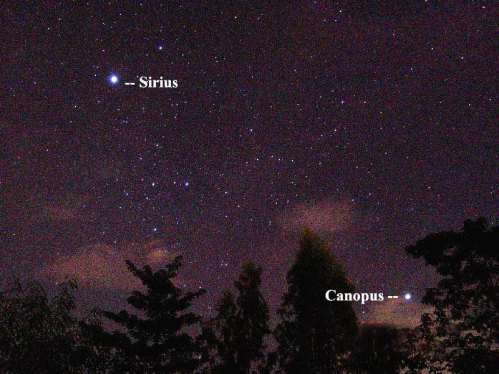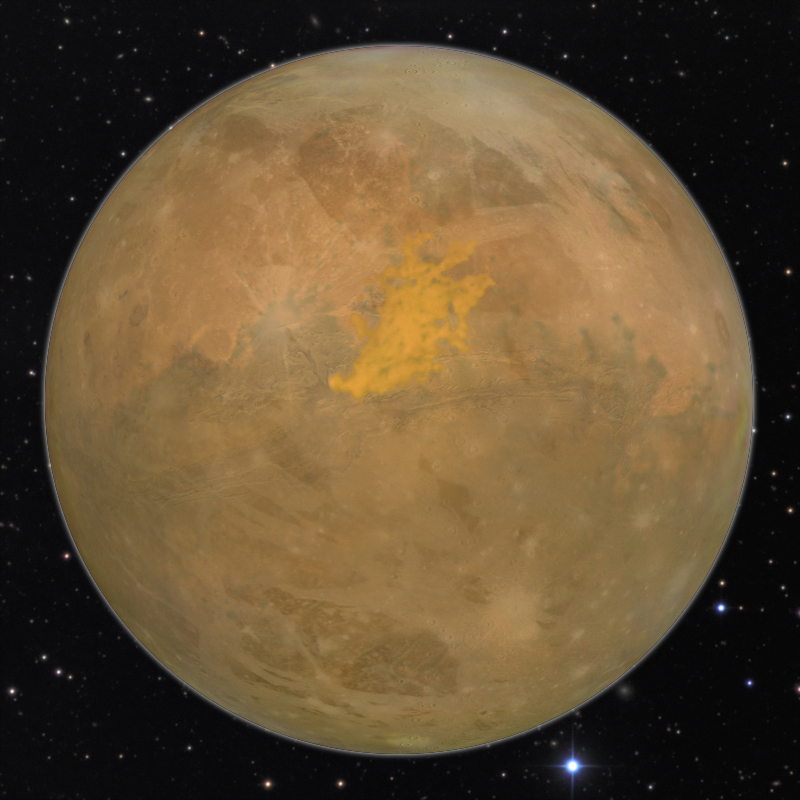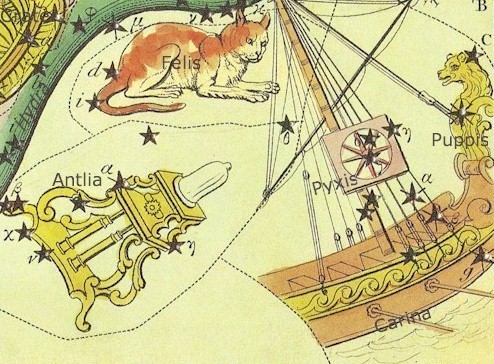
Can you see Canopus?
If you stay at latitudes like those in the northern U.S., you’ll never see Canopus. That’s why this star has become a holy grail of sorts for some Northern Hemisphere skywatchers, who take winter vacations at southerly latitudes (like those in the southern U.S.), just to catch a glimpse of it. From latitudes like those in the southern U.S., Canopus – the sky’s 2nd-brightest star – appears as a bright light closer to the horizon than Sirius (the sky’s brightest star). For those southerly observers, Canopus and Sirius arc across the south together on February evenings.
Will you see Canopus? It depends, basically, on how far south you are, and what time of year you’re looking. Canopus never rises above the horizon for locations north of about 37 degrees north latitude. In the United States, that line runs from roughly Richmond, Virginia; westward to Bowling Green, Kentucky; through Trinidad, Colorado and onward to San Jose, California. Here’s a list of global locations at the 37th parallel north. You must be south of that line to see Canopus.
Right now, February evenings are a perfect time to look for Canopus. Then this star is at its highest in the sky around 9 p.m. local time (the time on your clock no matter where you are on the globe). From the Northern Hemisphere, Canopus appears in the southern sky almost directly south of Sirius. When Sirius is at its highest point to the south, Canopus is about 36 degrees below it.
For observers in the Southern Hemisphere it’s an entirely different story. From latitudes south of the equator, both Canopus and Sirius – the sky’s brightest and 2nd-brightest stars – appear higher in the sky. They are like twin beacons crossing overhead together.
The sight of them is enough to make a northern observer envy the southern skies!
The 2022 lunar calendars are here. Order yours before they’re gone!


Canopus in science fiction
In Frank Herbert‘s 1965 novel Dune and other novels in his Dune universe, the fictional planet Arrakis is a vast desert world, home to sandworms and Bedouin-like humans called the Fremen. It is the 3rd planet from a real star in our night sky. That star is Canopus.
In Herbert’s novel, the desert planet Arrakis is the only source of “spice,” the most important and valuable substance in the Dune universe. This “spice” is what makes star travel possible, in this fictional universe.
It’s possible, according to Wikipedia (which references the famous book Star Names: Their Lore and Meaning by Richard Hinckley Allen), that Herbert was influenced in his choice of this star as the primary for Arrakis by a common etymological derivation of the name Canopus:
… as a Latinization (through Greek Kanobos) from the Coptic Kahi Nub (“Golden Earth”), which refers to how Canopus would have appeared over the southern desert horizon in ancient Egypt, reddened by atmospheric absorption.
And it’s true … from much of the classical world in ancient times, Canopus would have appeared low in the sky, when it was visible at all. And so, yes, its bright light would be reddened due to looking at it through a greater thickness of atmosphere in the direction toward the horizon. Just as our sun or moon seen low in the sky looks redder than usual. Golden Earth indeed.
By the way, although Arrakis is fictional, Canopus is not only very real but also much hotter and larger than our sun. See the Science section below.

Science of Canopus
According to data obtained by the Hipparcos Space Astrometry Mission, Canopus is about 310 light-years away.
Spectroscopically, it is an F0 type star, making it significantly hotter than our sun (roughly 13,600 degrees Fahrenheit or 7,500 degrees Celsius) at its surface. This is compared to about 10,000 degrees F or 5,500 degrees C for the sun.
Canopus also has a luminosity class rating of II, which makes it a “bright giant” star much larger than the sun. (Some classifications make it a type Ia “supergiant.”)
If they were placed side by side, it would take about 65 suns to fit across Canopus. Although Canopus appears significantly less bright than Sirius, it is really much brighter, blazing with the brilliance of 14,000 suns! With non-visible forms of light energy factored in, it surpasses the sun by more than 15,000 times.
Although its exact age is unknown, Canopus’ great mass dictates that this star must be near the end of its lifetime and is likely is a few million to a few tens of millions of years old. Compared to our sedate middle-aged five-billion-year-old sun, Canopus has lived in the stellar fast lane and is destined to die young.

History and mythology
Canopus is also called Alpha Carinae, the brightest star in the constellation Carina the Keel. This constellation used to be considered part of Argo Navis, the ship of Jason and his famed Argonauts, as seen in our sky. Canopus originally marked a keel or rudder of this ancient celestial ship. Alas, the great Argo Navis constellation no longer exists. Modern imaginations see it as broken into three parts: the Keel (Carina, of which Canopus is part), sails (Vela) and the poop deck (Puppis).
For those far enough south to see it, Canopus was a star of great importance from ancient times to modern times as a primary navigational star. This is surely due to its brightness.
The origin of the name Canopus is subject to question. By some accounts it is the name of a ship’s captain from the Trojan War. Another theory is that it is from ancient Egyptian meaning Golden Earth, a possible reference to the star’s appearance as seen through atmospheric haze near the horizon from Egyptian latitudes.
The position of Canopus is RA: 6h 23m 57s, Dec: -52° 41′ 45″

Bottom line: Canopus is the 2nd-brightest star as seen from Earth. To see Canopus, you must either be in the Southern Hemisphere or below the Northern Hemisphere’s 37th parallel north.
Enjoying EarthSky so far? Sign up for our free daily newsletter today!
The post Can you see Canopus, the 2nd-brightest star? first appeared on EarthSky.
from EarthSky https://ift.tt/DLzy5B6f1

Can you see Canopus?
If you stay at latitudes like those in the northern U.S., you’ll never see Canopus. That’s why this star has become a holy grail of sorts for some Northern Hemisphere skywatchers, who take winter vacations at southerly latitudes (like those in the southern U.S.), just to catch a glimpse of it. From latitudes like those in the southern U.S., Canopus – the sky’s 2nd-brightest star – appears as a bright light closer to the horizon than Sirius (the sky’s brightest star). For those southerly observers, Canopus and Sirius arc across the south together on February evenings.
Will you see Canopus? It depends, basically, on how far south you are, and what time of year you’re looking. Canopus never rises above the horizon for locations north of about 37 degrees north latitude. In the United States, that line runs from roughly Richmond, Virginia; westward to Bowling Green, Kentucky; through Trinidad, Colorado and onward to San Jose, California. Here’s a list of global locations at the 37th parallel north. You must be south of that line to see Canopus.
Right now, February evenings are a perfect time to look for Canopus. Then this star is at its highest in the sky around 9 p.m. local time (the time on your clock no matter where you are on the globe). From the Northern Hemisphere, Canopus appears in the southern sky almost directly south of Sirius. When Sirius is at its highest point to the south, Canopus is about 36 degrees below it.
For observers in the Southern Hemisphere it’s an entirely different story. From latitudes south of the equator, both Canopus and Sirius – the sky’s brightest and 2nd-brightest stars – appear higher in the sky. They are like twin beacons crossing overhead together.
The sight of them is enough to make a northern observer envy the southern skies!
The 2022 lunar calendars are here. Order yours before they’re gone!


Canopus in science fiction
In Frank Herbert‘s 1965 novel Dune and other novels in his Dune universe, the fictional planet Arrakis is a vast desert world, home to sandworms and Bedouin-like humans called the Fremen. It is the 3rd planet from a real star in our night sky. That star is Canopus.
In Herbert’s novel, the desert planet Arrakis is the only source of “spice,” the most important and valuable substance in the Dune universe. This “spice” is what makes star travel possible, in this fictional universe.
It’s possible, according to Wikipedia (which references the famous book Star Names: Their Lore and Meaning by Richard Hinckley Allen), that Herbert was influenced in his choice of this star as the primary for Arrakis by a common etymological derivation of the name Canopus:
… as a Latinization (through Greek Kanobos) from the Coptic Kahi Nub (“Golden Earth”), which refers to how Canopus would have appeared over the southern desert horizon in ancient Egypt, reddened by atmospheric absorption.
And it’s true … from much of the classical world in ancient times, Canopus would have appeared low in the sky, when it was visible at all. And so, yes, its bright light would be reddened due to looking at it through a greater thickness of atmosphere in the direction toward the horizon. Just as our sun or moon seen low in the sky looks redder than usual. Golden Earth indeed.
By the way, although Arrakis is fictional, Canopus is not only very real but also much hotter and larger than our sun. See the Science section below.

Science of Canopus
According to data obtained by the Hipparcos Space Astrometry Mission, Canopus is about 310 light-years away.
Spectroscopically, it is an F0 type star, making it significantly hotter than our sun (roughly 13,600 degrees Fahrenheit or 7,500 degrees Celsius) at its surface. This is compared to about 10,000 degrees F or 5,500 degrees C for the sun.
Canopus also has a luminosity class rating of II, which makes it a “bright giant” star much larger than the sun. (Some classifications make it a type Ia “supergiant.”)
If they were placed side by side, it would take about 65 suns to fit across Canopus. Although Canopus appears significantly less bright than Sirius, it is really much brighter, blazing with the brilliance of 14,000 suns! With non-visible forms of light energy factored in, it surpasses the sun by more than 15,000 times.
Although its exact age is unknown, Canopus’ great mass dictates that this star must be near the end of its lifetime and is likely is a few million to a few tens of millions of years old. Compared to our sedate middle-aged five-billion-year-old sun, Canopus has lived in the stellar fast lane and is destined to die young.

History and mythology
Canopus is also called Alpha Carinae, the brightest star in the constellation Carina the Keel. This constellation used to be considered part of Argo Navis, the ship of Jason and his famed Argonauts, as seen in our sky. Canopus originally marked a keel or rudder of this ancient celestial ship. Alas, the great Argo Navis constellation no longer exists. Modern imaginations see it as broken into three parts: the Keel (Carina, of which Canopus is part), sails (Vela) and the poop deck (Puppis).
For those far enough south to see it, Canopus was a star of great importance from ancient times to modern times as a primary navigational star. This is surely due to its brightness.
The origin of the name Canopus is subject to question. By some accounts it is the name of a ship’s captain from the Trojan War. Another theory is that it is from ancient Egyptian meaning Golden Earth, a possible reference to the star’s appearance as seen through atmospheric haze near the horizon from Egyptian latitudes.
The position of Canopus is RA: 6h 23m 57s, Dec: -52° 41′ 45″

Bottom line: Canopus is the 2nd-brightest star as seen from Earth. To see Canopus, you must either be in the Southern Hemisphere or below the Northern Hemisphere’s 37th parallel north.
Enjoying EarthSky so far? Sign up for our free daily newsletter today!
The post Can you see Canopus, the 2nd-brightest star? first appeared on EarthSky.
from EarthSky https://ift.tt/DLzy5B6f1

Aucun commentaire:
Enregistrer un commentaire